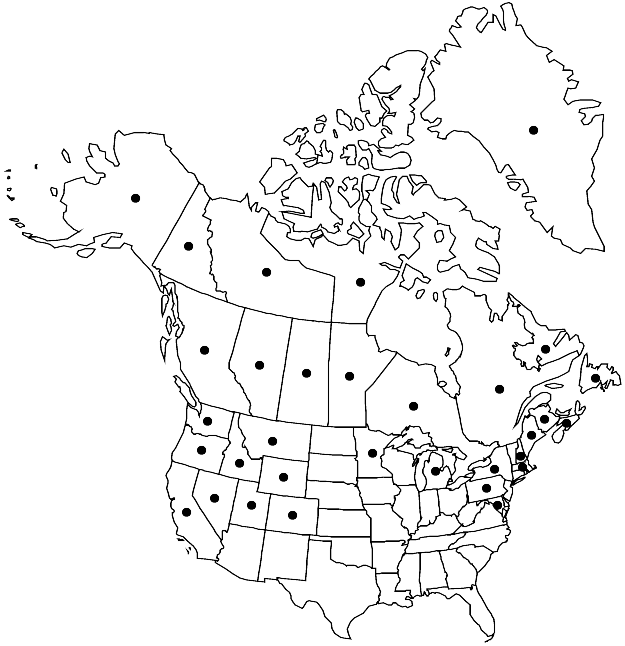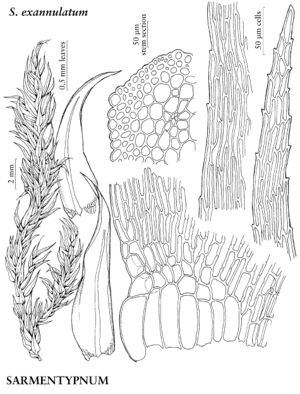Sarmentypnum exannulatum
J. Hattori Bot. Lab. 100: 132. 2006.
Plants medium-sized, green, yellowish, or with red secondary pigment. Stems with branch and shoot apices not pencil-like; epidermal-cells usually widened to form partial hyalodermis; axillary hair distal cells 1–4, hyaline when young. Stem-leaves ovate or ovate-triangular, gradually narrowed to apex, falcate or strongly so, sometimes straight, concave; base not decurrent; margins distinctly denticulate proximally, distally, or both; apex acuminate, sometimes furrowed but not strongly so; costa ending 3/5 to nearly entire leaf length; alar region from margins to costa or nearly so; marginal cells at widest part of leaf often differentiated from medial cells.
Habitat: Intermediately mineral-rich fens, around springs, late snow beds, submerged in lakes
Elevation: low to high elevations (0-4200 m)
Distribution

Greenland, Alta., B.C., Man., N.B., Nfld. and Labr., N.W.T., N.S., Nunavut, Ont., Que., Sask., Yukon, Alaska, Calif., Colo., Idaho, Maine, Md., Mass., Mich., Minn., Mont., Nev., N.H., N.Y., Oreg., Pa., Utah, Wash., Wyo., Mexico, South America, Eurasia, Africa, Pacific Islands (New Zealand), Australia
Discussion
Sarmentypnum exannulatum is one of the most frequent wetland species, with leaves that narrow gradually to the apex and are gradually curved throughout. The marginal laminal cells in the widest part of the stem leaves are often distinctly rectangular, distinctly widened, or both; this feature is never as pronounced in other species of Sarmentypnum as in S. exannulatum. However, because this feature is rather variable it should be used with caution when identifying material. Warnstorfia fluitans and W. pseudostraminea differ from S. exannulatum in being autoicous, having mainly narrowly triangular to lanceolate pseudoparaphyllia, hardly ever with pure red pigments, and with more weakly differentiated alar regions. The alar regions in W. fluitans usually reach less far distally in the leaf than in S. exannulatum, whereas those in W. pseudostraminea often form ovate regions together with the supra-alar cells. Phenotypes of S. exannulatum, found in springs, with inflated alar cells in more or less one row along the leaf base have been called W. exannulata var. purpurascens. However, transitions between these phenotypes and those from other habitats exist, and if the different phenotypes are cultivated together, the resulting plants cannot be separated (based on north European material).
Selected References
None.
Lower Taxa
"long-excurrent" is not a number.
